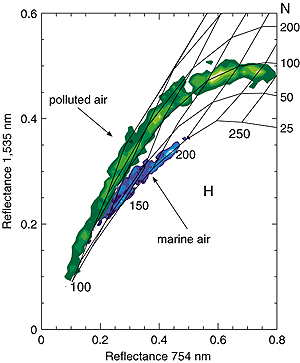Continued from previous page
|

Figure 5.6: Frequency distributions of the reflectances at 1,535
nm versus reflectances at 754 nm determined during the ACE-2 experiment.
Isolines of geometrical thickness (H) and droplet number concentration
(N) demonstrate the higher reflectance in polluted cloud if normalised
by a similar geometrical thickness (Brenguier et al. 2000).
|
In-situ measurement programmes have found linkages between
CCN concentrations and both drizzle and cloud droplet reff in marine
stratocumulus (cf., Hudson and Yum, 1997; Yum and Hudson, 1998). Moreover, several
studies have contrasted the microstructure of polluted and clean clouds in the
same airshed (e.g., Twohy et al., 1995; Garrett and Hobbs, 1995) while others
have linked seasonal variations in drop concentrations and reff with
seasonal variations in CCN (Boers et al., 1998). Indeed, recent studies by Rosenfeld
(1999, 2000) show a dramatic impact of aerosols on cloud precipitation efficiency.
Until recently, evidence of the impact of aerosols on cloud albedo itself has
been confined primarily to studies of ship tracks (e.g., Coakley et al., 1987;
Ferek et al., 1998; Ackerman et al., 2000) although some other types of studies
have indeed been done (e.g., Boers et al., 1998). However, new analyses have
not only identified changes in cloud microstructure due to aerosols but have
associated these changes with increases in cloud albedo as well. An example
of this, from Brenguier et al. (2000), can be seen in Figure 5.6, which displays
measured cloud reflectances at two wavelengths for clean and polluted clouds
examined during ACE-2. Thus, our understanding has advanced appreciably since
the time of the SAR and these studies leave little doubt that anthropogenic
aerosols have a non-zero impact on warm cloud radiative forcing. An estimate
of the forcing over oceans (from satellite studies) ranged from -0.7 to -1.7
Wm-2 (Nakajima et al., 2001).
For cirrus clouds, much of both the observational and theoretical support for
indirect forcing by anthropogenic aerosols has been recently summarised in the
report on the impact of aviation-derived aerosols on clouds (Fahey et al., 1999).
There is a remarkably consistent upward trend in cirrus fractional cloudiness
in areas of high air traffic over the last two decades observable, in at least
broad outline, in both ground-based and satellite databases (Fahey et al., 1999).
The suggested increase in cirrus cloud cover of about 4% since 1971 is much
larger than can be attributed to linear-shaped contrails, with the resulting
implication that aviation emissions are perturbing high altitude cloud amount.
While purely meteorological trends (i.e., increasing upper atmospheric water
vapour, changing circulation patterns) and/or increases associated with surface-based
emissions cannot be excluded as a possible cause for these trends, these observations
are very suggestive of a perturbation from aviation emissions.
